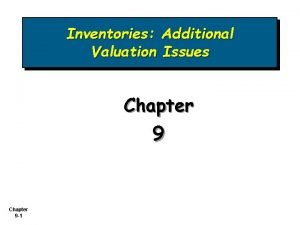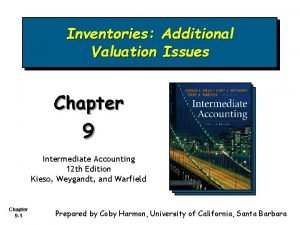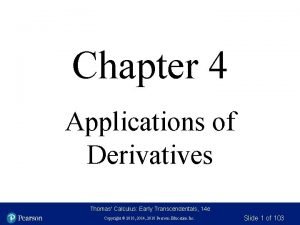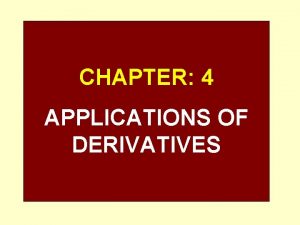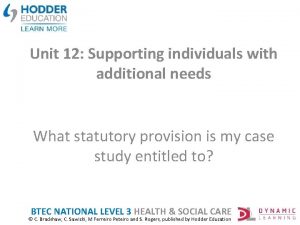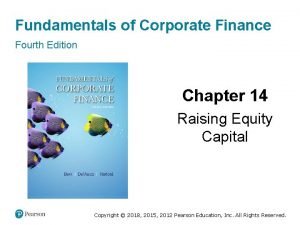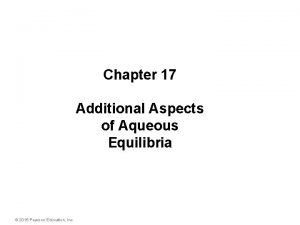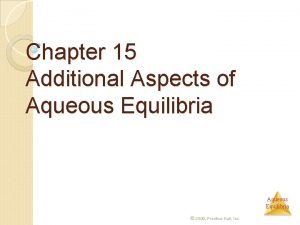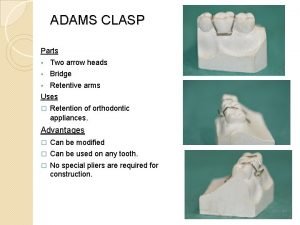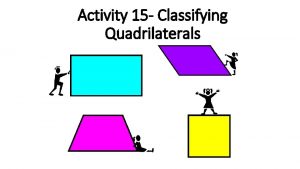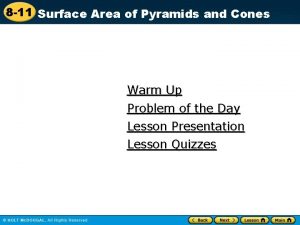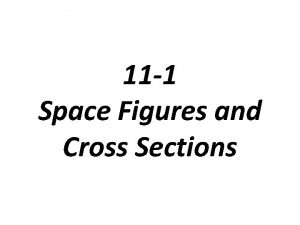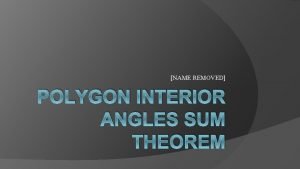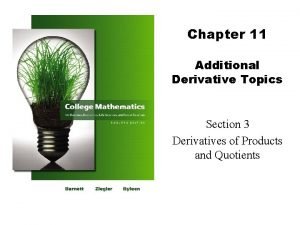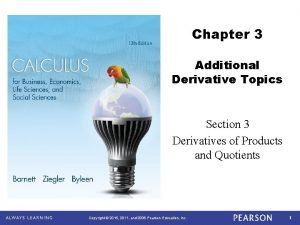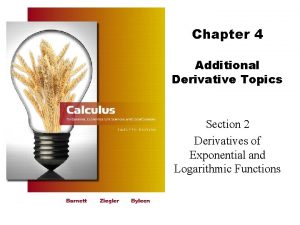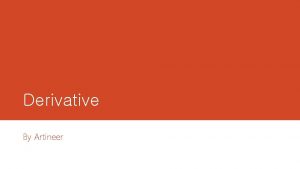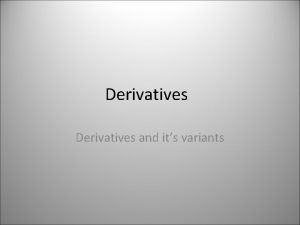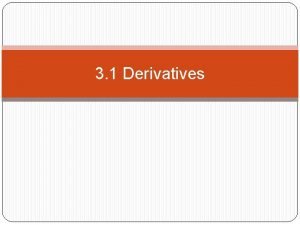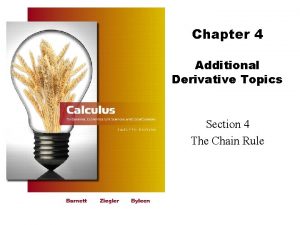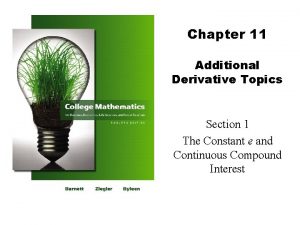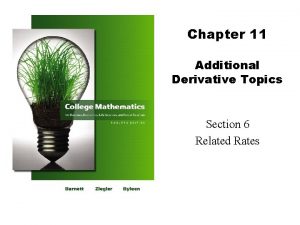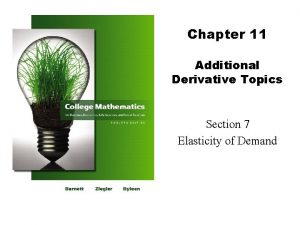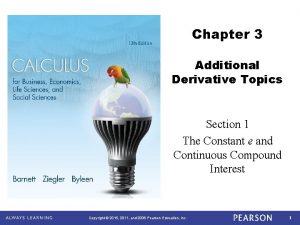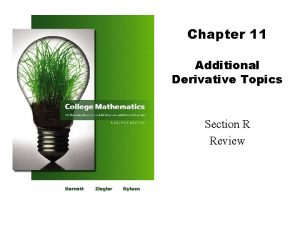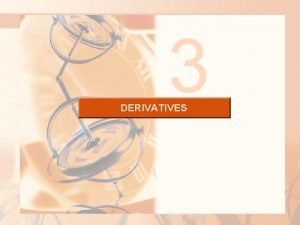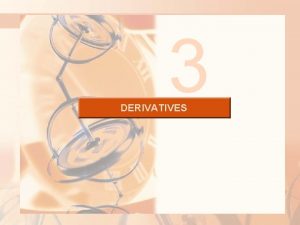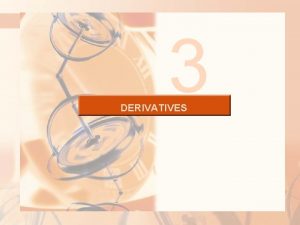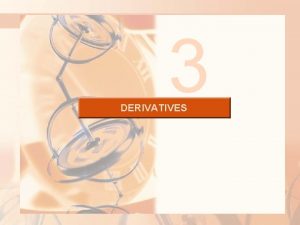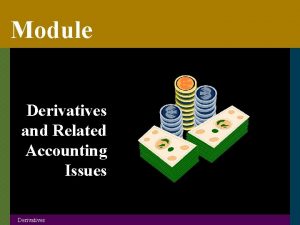Chapter 3 Additional Derivative Topics Section 2 Derivatives




















- Slides: 20

Chapter 3 Additional Derivative Topics Section 2 Derivatives of Exponential and Logarithmic Functions Copyright © 2015, 2011, and 2008 Pearson Education, Inc. 1

Objectives for Section 3. 2 Derivatives of Exp/Log Functions ■ The student will be able to calculate the derivative of ex and of ln x. ■ The student will be able to compute the derivatives of other logarithmic and exponential functions. ■ The student will be able to derive and use exponential and logarithmic models. Copyright © 2015, 2011, and 2008 Pearson Education, Inc. 2 2

The Derivative of ex We will use (without proof) the fact that We now apply the four-step process from a previous section to the exponential function. Step 1: Find f (x+h) Step 2: Find f (x+h) – f (x) Copyright © 2015, 2011, and 2008 Pearson Education, Inc. 3 3

The Derivative of ex (continued) Step 3: Find Step 4: Find Copyright © 2015, 2011, and 2008 Pearson Education, Inc. 4 4

The Derivative of ex (continued) Result: The derivative of f (x) = ex is f ´(x) = ex. Caution: The derivative of ex is not x ex– 1 The power rule cannot be used to differentiate the exponential function. The power rule applies to exponential forms xn, where the exponent is a constant and the base is a variable. In the exponential form ex, the base is a constant and the exponent is a variable. Copyright © 2015, 2011, and 2008 Pearson Education, Inc. 5 5

Examples Find derivatives for f (x) = ex/2 f (x) = 2 ex + x 2 f (x) = – 7 xe – 2 ex + e 2 Copyright © 2015, 2011, and 2008 Pearson Education, Inc. 6 6

Examples (continued) Find derivatives for f (x) = ex/2 f ´(x) = (1/2) ex/2 f (x) = 2 ex +x 2 f ´(x) = 2 ex + 2 x f (x) = – 7 xe – 2 ex + e 2 f ´(x) = – 7 exe-1 – 2 ex Remember that e is a real number, so the power rule is used to find the derivative of xe. The derivative of the exponential function ex, on the other hand, is ex. Note also that e 2 ≈ 7. 389 is a constant, so its derivative is 0. Copyright © 2015, 2011, and 2008 Pearson Education, Inc. 7 7

The Natural Logarithm Function ln x We summarize important facts about logarithmic functions from a previous section: Recall that the inverse of an exponential function is called a logarithmic function. For b > 0 and b ≠ 1 Logarithmic form is equivalent to Exponential form y = logb x x = by Domain (0, ∞) Domain (–∞ , ∞) Range (0, ∞) The base we will be using is e. ln x = loge x Copyright © 2015, 2011, and 2008 Pearson Education, Inc. 8 8

The Derivative of ln x We are now ready to use the definition of derivative and the four step process to find a formula for the derivative of ln x. Later we will extend this formula to include logb x for any base b. Let f (x) = ln x, x > 0. Step 1: Find f (x+h) Step 2: Find f (x + h) – f (x) Copyright © 2015, 2011, and 2008 Pearson Education, Inc. 9 9

The Derivative of ln x (continued) Step 3: Find Step 4: Find . Let s = x/h. Copyright © 2015, 2011, and 2008 Pearson Education, Inc. 10 10

Examples Find derivatives for f (x) = 5 ln x f (x) = x 2 + 3 ln x f (x) = 10 – ln x f (x) = x 4 – ln x 4 Copyright © 2015, 2011, and 2008 Pearson Education, Inc. 11 11

Examples (continued) Find derivatives for f (x) = 5 ln x f ´(x) = 5/x f (x) = x 2 + 3 ln x f ´(x) = 2 x + 3/x f (x) = 10 – ln x f ´(x) = – 1/x f (x) = x 4 – ln x 4 f ´(x) = 4 x 3 – 4/x Before taking the last derivative, we rewrite f (x) using a property of logarithms: ln x 4 = 4 ln x Copyright © 2015, 2011, and 2008 Pearson Education, Inc. 12 12

Other Logarithmic and Exponential Functions Logarithmic and exponential functions with bases other than e may also be differentiated. Copyright © 2015, 2011, and 2008 Pearson Education, Inc. 13 13

Examples Find derivatives for f (x) = log 5 x f (x) = 2 x – 3 x f (x) = log 5 x 4 Copyright © 2015, 2011, and 2008 Pearson Education, Inc. 14 14

Examples (continued) Find derivatives for f (x) = log 5 x f ´(x) = f (x) = 2 x – 3 x f ´(x) = 2 x ln 2 – 3 x ln 3 f (x) = log 5 x 4 f ´(x) = For the last example, use log 5 x 4 = 4 log 5 x Copyright © 2015, 2011, and 2008 Pearson Education, Inc. 15 15

Summary Exponential Rule For b > 0, b ≠ 1 Log Rule Copyright © 2015, 2011, and 2008 Pearson Education, Inc. 16 16

Application On a national tour of a rock band, the demand for T-shirts is given by p(x) = 10(0. 9608)x where x is the number of T-shirts (in thousands) that can be sold during a single concert at a price of $p. 1. Find the production level that produces the maximum revenue, and the maximum revenue. Copyright © 2015, 2011, and 2008 Pearson Education, Inc. 17 17

Application (continued) On a national tour of a rock band, the demand for T-shirts is given by p(x) = 10(0. 9608)x where x is the number of T-shirts (in thousands) that can be sold during a single concert at a price of $p. 1. Find the production level that produces the maximum revenue, and the maximum revenue. R(x) = xp(x) = 10 x(0. 9608)x Graph on calculator and find maximum. Copyright © 2015, 2011, and 2008 Pearson Education, Inc. 18 18

Application (continued) 2. Find the rate of change of price with respect to demand when demand is 25, 000. Copyright © 2015, 2011, and 2008 Pearson Education, Inc. 19 19

Application (continued) 2. Find the rate of change of price with respect to demand when demand is 25, 000. p´(x) = 10(0. 9608)x(ln(0. 9608)) = – 0. 39989(0. 9608)x Substituting x = 25: p´(25) = -0. 39989(0. 9608)25 = – 0. 147. This means that when demand is 25, 000 shirts, in order to sell an additional 1, 000 shirts the price needs to drop 15 cents. (Remember that p is measured in thousands of shirts). Copyright © 2015, 2011, and 2008 Pearson Education, Inc. 20 20
 Additional topics in trigonometry
Additional topics in trigonometry Chapter 9 inventories additional valuation issues
Chapter 9 inventories additional valuation issues Chapter 9 inventories additional valuation issues
Chapter 9 inventories additional valuation issues Chapter 4 applications of derivatives
Chapter 4 applications of derivatives Chapter 4 applications of derivatives
Chapter 4 applications of derivatives Chapter 10 section 1 meiosis worksheet answer key
Chapter 10 section 1 meiosis worksheet answer key Fire watchers are additional personnel
Fire watchers are additional personnel Unit 12 additional needs
Unit 12 additional needs Uc application personal statement
Uc application personal statement School health additional referral program
School health additional referral program Ipo chart c++
Ipo chart c++ Additional aspects of aqueous equilibria
Additional aspects of aqueous equilibria Additional aspects of aqueous equilibria
Additional aspects of aqueous equilibria 10-5 secant lines and segments
10-5 secant lines and segments Labial bow wire gauge
Labial bow wire gauge Lesson 15-2 trapezoids
Lesson 15-2 trapezoids 11-3 surface areas of pyramids and cones
11-3 surface areas of pyramids and cones Space figures and cross sections
Space figures and cross sections Information letter
Information letter Additional roles reimbursement scheme
Additional roles reimbursement scheme What is the name of this polygon?
What is the name of this polygon?

